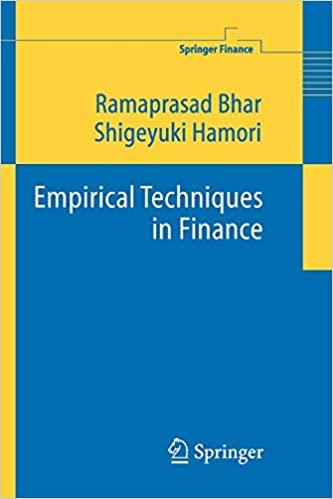Answered step by step
Verified Expert Solution
Question
1 Approved Answer
D. In equation (1), is 0.2 an elasticity? Explain briefly why or why not. 1. (The first paragraph provides some context that I hope makes


D. In equation (1), is 0.2 an elasticity? Explain briefly why or why not.
1. (The first paragraph provides some context that I hope makes the problem more interesting, but the information in this paragraph is not necessary to correctly answer the questions below.) Suppose you work for an automotive manufacturer and are setting terms for a new vehicle leasing program. In particular, the manufacturer must set the lease-end residual value for the lease contract; this is the expected value of the vehicle at the end of the lease period. The lease customer ("lessee") could choose to purchase the vehicle at this price at the end of the lease. - If the manufacturer sets the lease-end residual value too low, then it gives the lessee a windfall (the lessee could purchase the car and resell it at a higher price). - If the manufacturer sets the lease-end residual value too high, then it discourages leasing because the customer cost (down payment and lease payments) will be higher. Suppose we have determined that for a vehicle with a retail price of 40 thousand dollars when new and which is driven 12,000 miles per year and which receives all recommended maintenance, the market value of the vehicle after t years of service is given by (1) y=40exp(0.0250.2t)=40e0.0250.2t Where market value y is measured in thousands of dollars; e.g., y=20 means $20,000 market value. A. Using non-linear equation (1), calculate the market value y after three years of service (t=3) and after five years of service. Further, calculate the simple (discrete) proportional change in y when the vehicles goes from three years of service to five years of service (i.e., the market value with three years of service is the base for the calculation). B. Apply the natural log transformation to equation (1). Does the transformed equation exhibit constant marginal effect? Explain briefly. C. (i) Use the slope term from your transformed equation from part B to directly calculate the continuous proportional change in y when years of service increases from three years to five years. decreases from $2.50 to $2. 1. (The first paragraph provides some context that I hope makes the problem more interesting, but the information in this paragraph is not necessary to correctly answer the questions below.) Suppose you work for an automotive manufacturer and are setting terms for a new vehicle leasing program. In particular, the manufacturer must set the lease-end residual value for the lease contract; this is the expected value of the vehicle at the end of the lease period. The lease customer ("lessee") could choose to purchase the vehicle at this price at the end of the lease. - If the manufacturer sets the lease-end residual value too low, then it gives the lessee a windfall (the lessee could purchase the car and resell it at a higher price). - If the manufacturer sets the lease-end residual value too high, then it discourages leasing because the customer cost (down payment and lease payments) will be higher. Suppose we have determined that for a vehicle with a retail price of 40 thousand dollars when new and which is driven 12,000 miles per year and which receives all recommended maintenance, the market value of the vehicle after t years of service is given by (1) y=40exp(0.0250.2t)=40e0.0250.2t Where market value y is measured in thousands of dollars; e.g., y=20 means $20,000 market value. A. Using non-linear equation (1), calculate the market value y after three years of service (t=3) and after five years of service. Further, calculate the simple (discrete) proportional change in y when the vehicles goes from three years of service to five years of service (i.e., the market value with three years of service is the base for the calculation). B. Apply the natural log transformation to equation (1). Does the transformed equation exhibit constant marginal effect? Explain briefly. C. (i) Use the slope term from your transformed equation from part B to directly calculate the continuous proportional change in y when years of service increases from three years to five years. decreases from $2.50 to $2Step by Step Solution
There are 3 Steps involved in it
Step: 1

Get Instant Access to Expert-Tailored Solutions
See step-by-step solutions with expert insights and AI powered tools for academic success
Step: 2

Step: 3

Ace Your Homework with AI
Get the answers you need in no time with our AI-driven, step-by-step assistance
Get Started


